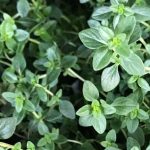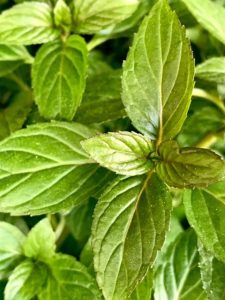Starting to think about your summer garden?
There are so many vegetables that thrive in New Jersey soil. How lucky are we to live in the Garden State? Why not add some healing herbs this year? How nice would it be to walk out to your garden or even your kitchen sill and just snip, snip your upset stomach away? There is such a wide variety to choose from, so let’s just focus on 5 to get started.
GERMAN CHAMOMILE
How it can help
Chamomile is known to help reduce anxiety levels and bring on sleep, both of which are crucial to our health. Argentinean researchers discovered recently that a compound in chamomile oil binds to the same receptors as the Valium family of tranquilizers and anti-anxiety drugs. When Japanese researchers exposed animals under stress to chamomile vapors, the animals’ stress-hormone levels fell significantly. Chamomile can also soothe upset stomachs and may help relieve menstrual cramps.
Grow it
This annual bushy shrub is easy to grow from seed or from cutting. It’s extremely low maintenance outdoors in full sun, but you can also grow it potted indoors in a very sunny window.
Drink it
To make a tea, pick chamomile flowers and lay them out to dry at room temperature out of direct sun for about a week. Store in a dry, well-sealed jar. Steep 1 to 2 tablespoons of dried blossoms in boiling water for about 10 minutes.
PEPPERMINT
How it can help
Peppermint is a potent stomach-soother; studies have found it to relieve digestive distress in sufferers of chronic indigestion. A mild anesthetic, peppermint can also help ease the pain of sore throats. Menthol, its active ingredient, helps treat colds and congestion.
Grow it
Peppermint is among the hardiest plants in the garden. It can grow in partial sun and will grow well indoors from seed provided it gets at least some sun each day. Peppermint doesn’t need much water; allow the soil to dry between watering. Peppermint needs room to spread. Plant seeds in a large pot, then thin to one plant every 12 inches once plants reach about 2 inches tall. Even one strong seedling will quickly spread to fill an entire pot.
Eat it and Drink it
Peppermint makes a delicious hot or iced tea, and can also be muddled and mixed with soda water (and sugar, if desired) for a refreshing beverage. Pour a cup of boiling water over 2 teaspoons of fresh leaves or 1 teaspoon of crushed, dried leaves. Steep, covered, for 10 minutes. Use more or less herb according to your preference. Drink a cup of this tea up to three times a day to aid digestion. Mint is common in Thai dishes such as spring rolls and Middle Eastern dishes such as tabbouleh salad. You can also make a simple mint sauce to complement lamb or other meats by combining fresh mint with sugar and vinegar.
OREGANO
 How it can help
How it can help
Studies have found that a compound in oregano called carvacrol can help prevent inflammation lessening some symptoms of arthritis. Oregano is also high in several antioxidants including phenols and flavonoids, both of which are thought to protect against chronic diseases such as cancer.
Grow it
Hardy, perennial oregano is extremely easy to grow provided it has ample light. Find a window with at least six hours of bright light, or place oregano under fluorescent or grow lights. Grow oregano in 6-inch pots and it will assume a trailing nature. Pinch off leaves regularly to encourage an increased harvest. Plant in well-draining soil, and let the soil dry slightly between watering.
Eat it
A classic in Italian sauces such as marinara and pizza sauce, oregano is also extremely common in both Mediterranean and Mexican cooking. Add oregano to poultry, seafood, chili, vinaigrettes and more.
HOLY BASIL
 How it can help
How it can help
This close relative of common basil is native to India, Sri Lanka, Malaysia, and has gained recent popularity as a tasty herbal tea. Holy basil is highly aromatic and antimicrobial; the leaves and flowers are used as a medicinal tea for colds, coughs, asthma, bronchitis, sinusitis, headaches, arthritis, diabetes, stress, and anxiety.
Grow it
Plant outside in full sun. It is easy to grow from seed, but do not plant too deep. Holy Basil may appear tiny when you first plant it, but once the nighttime temperatures warm up, it will take off!
Eat it and Drink it
To make Holy Basil Tea, wash the leaves well and place them in a cup. With the back of a spoon, press the leaves against the side of the cup. Pour hot (not boiling) water over the leaves and stir. Wait 5 minutes and drink warm. Use fresh leaves on salads or pasta or make a fabulous pesto!
STINGING NETTLES
How it can help
The leaves and seeds are used medicinally in teas, and as a food, for allergies, arthritis, and as a kidney tonic. The greens and tea of nettles are high in minerals, vitamins, and chlorophyll, namely Vitamin A and C and calcium, potassium, magnesium, and iron.
Grow it
Nettles is an herbaceous perennial. It likes full sun to part shade in a rich moist soil. Plant it out of the way or inside a semi-buried barrier as it will spread prolifically.
Eat it and Drink it
Use gloves when handling! Once cooked, their stinging powers are wiped out. Phew! You can use Stinging Nettles anywhere you would use spinach. Try them in pasta, spanakopita or a soup. Check out this link for some yummy recipes.. To make tea, simply add 2 cups water to about a cup of leaves and bring to a near boil. Reduce heat and simmer for a couple of minutes.
Feeling adventurous?
Want to expand your garden oasis? These herbs also contain wonderful healing properties; Lavender, Echinacea, Marigold, Parsley, and Sage. I highly recommend getting your children involved. Gardening is a magical teaching opportunity and a technology-free way to share summer days.
Here’s to a beautiful summer and a bountiful garden.
